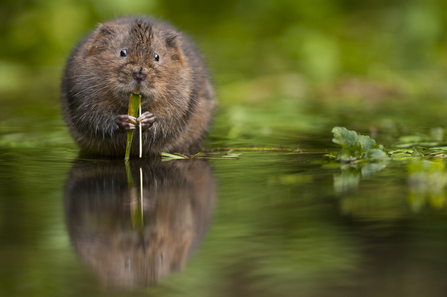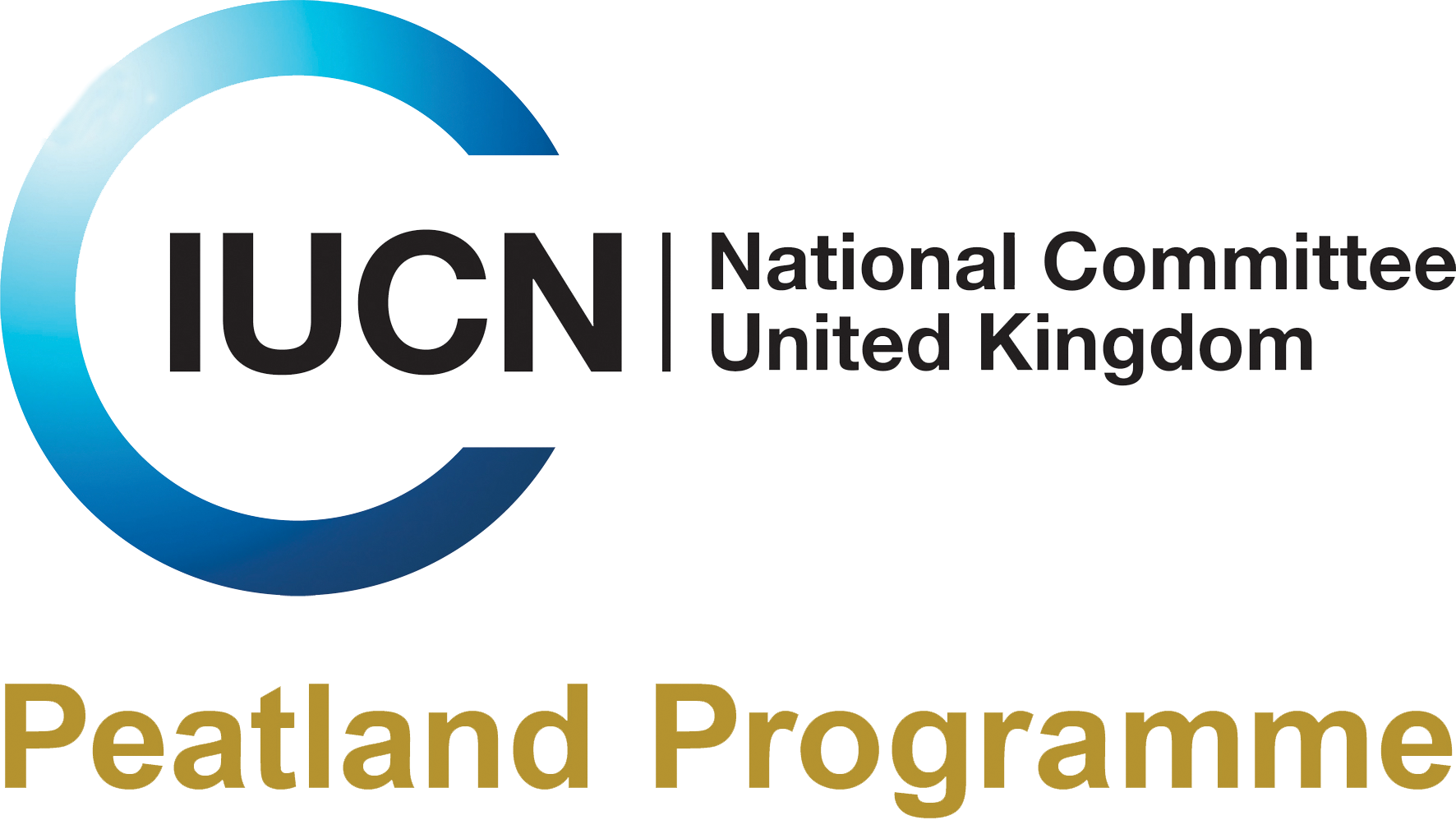A brown little face, with whiskers.
A grave round face, with the same twinkle
in its eye that had first attracted his notice.
Small neat ears and thick silky hair.
It was the Water Rat!
Kenneth Grahame, Wind in the Willows (1908)
Water vole sitting with blackberries. Credit: Jenny Hibbert.
Water voles are commonly associated with rivers and streams, much like the character Ratty who lived on a riverbank in the children’s novel “The Wind in the Willows”. More unusual water vole populations have been found in urban areas such as Glasgow, where they construct underground burrows in public parks and grasslands away from water.1 However, did you know that water voles are also a common peatland species? They inhabit lowland fens dominated by reedbeds but are also just as comfortable in ditches and rivers surrounding upland peatlands across the UK, all the way up to a thousand meters above sea level in northern Scotland! 2 The interconnectedness of these habitats from sea to summit is essential for supporting biodiversity and allowing Water voles to move across this wide range. This involves consideration of peatland, wetland, and wider watercourse conservation.
A mini ecosystem engineer
The water vole (Arvicola amphibius) is a small mammal (14-22 cm in length) that is often confused with the brown rat. However, with a closer look, water voles are quite different in appearance from rats. They can be identified by their small, round ears, short blunt nose and furry tail and paws. The coat of the water vole is usually a chestnut brown, although darker, black-coated water voles can be found in Scotland.
As herbivores consuming 80% of their body weight every day, water voles prefer open landscapes adjacent to water, with plenty of light to support lush vegetation. They eat grass and riparian (bankside) vegetation, but also twigs, roots, bulbs, and fruit. In fact, 277 plant species have been identified as part of their diet!3 During pregnancy, female water voles may supplement their diet with protein-rich pollen from flowers, as well as invertebrates and small fish.

Water Vole. Credit Philip Braude.
Water voles prefer to eat at the same place, and will leave behind bits of grass or stems, nibbled at a 45-degree angle at the ends. Coming across one of these ‘feeding stations’ is a sign that water voles are in the area! Another clue is finding a ‘latrine’ – female water voles mark their territory during the breeding season (April – October) by leaving piles of droppings at the edges of their territory.
Using their strong, enamel-coated orange teeth, water voles construct burrows in the banks of freshwater bodies, or weave round nests above ground in reed beds where no suitable banks exist. Water vole burrows usually have two entrances – one on the bank, and another underwater that can be used as an escape route. Being close to water allows them to make a quick escape from predators, making a distinct ‘plop’ sound as they dive into the water when alerted to approaching danger.
Much like beavers, water voles are ecosystem engineers, albeit smaller in size and impact. Burrowing and foraging disturbs the environment and creates space in grass-dominated landscapes for other species to establish once the disturbance is over, which may increase local species richness. 4 Abandoned water vole burrows are also often used by other small mammals, as well as reptiles and amphibians.5
Water voles are widespread throughout mainland UK but absent from most islands and Northern Ireland. Sadly, water vole populations have been facing a rapid decline.
Water vole. Credit Peter Trimming.
Britain’s fastest declining mammal
Water voles are one of the UK's most threatened mammals, and we have lost up to 90% of the water vole population since the 1970s. In 2024, the estimated water vole population was made up of 58,341 - 186,142 individuals, but this is only a small fraction of the population that existed 60 years ago.5 Water voles have been affected by habitat loss due to land use change. Peatland drainage and the mowing and grazing of vegetation on the banks of freshwater bodies renders these habitats unsuitable for water voles.
Water voles have adapted to live with their many natural, native enemies, such as buzzards, foxes, owls, herons, and weasels. However, the non-native American mink that was introduced to the UK in the 1960s after fur farms closed is one of the main reasons for water vole decline. As the main prey of American mink – the muskrat – is missing from the UK, they prey on water voles instead. Female minks are small enough to reach into the burrows of water voles and can eradicate entire water vole populations in an area.
For these reasons, water voles are listed as endangered on both the Great Britain and England Red Lists for Mammals, and they are protected in the UK under the Wildlife and Countryside Act, 1981. This means that water voles are subject to licencing for any activities that disturb them, and they may need to be relocated if work (e.g. peatland restoration) is being undertaken in an area with a local water vole population.
Water voles (https://www.youtube.com/watch?v=fByN6990IVg)
Water voles. Credit The Wildlife Trusts.
Mapping the water voles of UK: conservation works
To determine how serious the decline in water vole populations is, The Wildlife Trusts established The National Water Vole Database Project in 2008, delivered by Hampshire & Isle of Wight Wildlife Trust.5 This project collates water vole survey records to map water vole distribution and identify important areas for conservation. The project also collects data on the distribution of American mink. It is crucial to monitor water vole populations continuously to inform conservation efforts with the latest data. For example, current distribution maps can be used for ecological network mapping to inform local plans.5
The latest report recently published by the project reveals that we have managed to halt the decline of water voles in some areas, with conservation efforts such as habitat restoration and reintroductions supporting population recovery. Sadly, their overall range continues to shrink, and water voles still urgently need our help – here is how you can get involved!
Keeping water voles safe during peatland restoration
Peatland rewetting is hugely important to create more suitable and extensive habitats for the water vole to thrive. However, small populations of water voles have often settled in ditches that have historically been dug around peatlands to drain them for other uses. This can cause challenges at the early stages of peatland restoration work, as infilling of drainage ditches is key to restoring the watery environment of a healthy bog. So, what can we do with existing populations?
Such a challenge was faced at Winmarleigh moss in Lancashire, where water voles had made themselves home in the drainage ditches bordering a degraded agricultural peatland site set for restoration and rewetting. Lancashire Wildlife Trust surveyed the land to make sure none of the areas with existing burrows would be filled in, ensuring that the local water voles were safe during rewetting works. The project also foresees new water channels being dug to convey water across the site as part of a nearby carbon farm, which will create even more habitats for the water voles.
Another example is the RSPB restoration project in Lakenheath Fen, where previously arable peatland was restored to a rich fenland. A habitat survey detected water voles in most of the ditches on the plot that was set for restoration, which led to extensive mitigation and displacement works. This included live trapping the water voles and relocating them to nearby ditches, costing tens of thousands of pounds. Protected species work is a legal requirement, and there are specific rules when it comes to water voles – for example, you cannot relocate two males in adjacent territories. Large areas of Lakenheath Fen have now been restored from carrot fields to vast reedbeds that are now home to water voles, otters, and many birds - and the site is open to visitors to explore and enjoy. There is a balance here between protection of individual species and the wider benefits that can be delivered through ecosystem restoration. This is a challenge that must be balanced on all restoration sites, and trade-offs should be considered on a site-specific basis. Guidance exists to help make these decisions and inform good practice species translocation and introductions, such as the IUCN Guidelines for reintroductions and other conservation translocations.
Water voles moving in: an example from Wales
Little does the tiny water vole realise how central it is to peatland restoration planning: the surveys, design, mitigation measures, schedules, delivery, and ongoing mapping. For example, the National Peatland Action Programme’s (NPAP) direct delivery around Hafod Elwy in north-east Wales was purposefully extended to three years to accommodate water voles.
In contrast, at NPAP’s Carn Fflur peatland site in mid-Wales, no pre-restoration water vole activity was recorded. There was great excitement during the post-restoration survey when the licenced ecologist soon found traces of “water voles everywhere”.
Wildlife lovers across the UK will join in site manager Jack Simpson’s delight with the results: “It was terrific to see such quick and extensive biodiversity gain after restoration, and especially to find water voles thriving!” The news reached as far as the species champion at the National Assembly of Wales. ‘Water Vole Champion’, John Griffiths SM, viewed with delight the map showing the initial absence followed by the current peppering of water vole activity.
Carn Fflur is on the Tywi Welsh Government Woodland Estate, managed by Natural Resources Wales, which provides NPAP with opportunities for best practice forest-to-bog restoration delivery. For any information contact: npap@naturalresourceswales.gov.uk.
The re-wetted landscape after NPAP restoration at Carn Fflur led to the arrival of water voles previously unrecorded at this site. Credit Wales National Peatland Action.
How to get involved
There are lots of ways you can help record water voles and support conservation efforts. Visit the National Water Vole Database Project webpage and the Water Vole to find out more.
A practical, illustrated field guide to help with water vole surveys can be found here.
Government guidance on water voles and development in England can be found here.
The Wildlife Trusts work on water vole recovery projects at landscape scale around the UK, including in Wales, Nottinghamshire, Warwickshire and Suffolk.
Images from Elliot Hook, Jenny Hibbert, and Philip Braude with permission from Mammal Society.
References
- Stewart RA, Clark TJ, Shelton J, Stringfellow M, Scott C, White SA, et al. Urban grasslands support threatened water voles. Journal of Urban Ecology. 2017;3(1):1-7.
- Harris S, Yalden DW. Mammals of the British Isles: Handbook. 4th ed. The Mammal Society; 2008.
- The Mammal Society. Water Vole [Internet]; 2025. Available from: Water vole — Mammal Society
- The Wildlife Trusts. Water voles: ecological engineers. [Internet]; 2018. Available from: Water voles: ecological engineers | The Wildlife Trusts.
- The Wildlife Trusts. The National Water Vole Database Project. [Internet]; 2025. Available from: The National Water Vole Database Project | The Wildlife Trusts.
